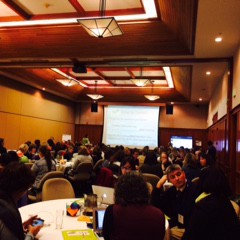I firmly believe that my job is more than teaching my students in my classroom. It’s more than meeting with their parents and connecting with the staff at my school and my district. Part of my job is making the public aware of positive stories from school.
Recently our district community relations person started emailing all staff every month, reminding them to send her notices of any good news she should share. Every month I try to be aware of things going on that I should highlight for her that would make good news stories. Over the years my class–alone or with other classes–has been in the paper or on local TV for Decade Days or Amigos Centers or Market Day. I know that in our area, the newspapers are eager for positive stories about our schools, which is heartening!
The last few years I’ve wanted to push that idea even further. I’ve started taking more opportunities to nominate people for awards–even awards that seem like a stretch. Ok, the first one wasn’t so hard. A year ago I nominated our head custodian Thad Bayes for the STAR 101.5 school support staff award, which he won. That was cool.
Then I put together a team from my school to nominate our former principal Joe Davalos for one of the WEA Human and Civil Rights Awards. He won the Community Service Award in April! That was amazing!
This fall I saw an ad in the Kitsap Sun for the “20 Under 40” award. I read the requirements: the person had to work on the Kitsap Peninsula, had to be under the age of 40, and had to have demonstrated exceptional leadership skills in the workplace and/or community. The award was sponsored by the Kitsap Sun and the Kitsap Peninsula Business Journal. They said they were looking for professionals in business, medicine, and education.
I nominated one of our teachers, Kristy Dressler.
By the way, I went into the Sun website much later to look through the past winners. I couldn’t find them all–they don’t post the winners back to the first year they gave out the awards. But I found very, very, very few representatives from the world of education. I think there were two principals and two private school teachers–a music school owner/teacher and a Montessori teacher. If I’d looked there first, I might have been scared off.
Nevertheless, Kristy won!
The Sun called to tell me the news and I started to cry. I went to Kristy’s room and told her and we both cried. Then she asked me why I nominated her when there are so many good teachers out there.
I have good reasons. First, she’s under 40. There are a lot of good teachers who aren’t! Second, I have been impressed with her from day one. She doesn’t just teach her class. She gets deeply involved with the school, parents, and the community. She trains staff. She works on district and regional committees. She’s a powerhouse. And she was a National Board candidate last year. (By the way, a couple of weeks later we learned she had passed, on her first try. Just another example of how she’s amazing.) Third, of course there are other teachers I could nominate. But I could only do one this year.
I can always nominate someone else next year.
How many ways can I find to shine the public spotlight on my really exceptional colleagues? I’m having so much fun finding out.
